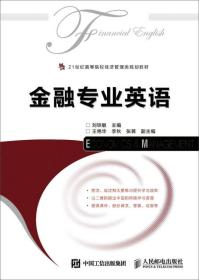
金融专业英语 [刘铁敏, 主编]
¥ 9.61 2.1折 ¥ 46 八五品
仅1件
河南郑州
认证卖家担保交易快速发货售后保障
作者刘铁敏 编
出版社人民邮电出版社
出版时间2015-07
版次1
装帧平装
货号41880
上书时间2021-07-19
- 店主推荐
- 最新上架
商品详情
- 品相描述:八五品
图书标准信息
- 作者 刘铁敏 编
- 出版社 人民邮电出版社
- 出版时间 2015-07
- 版次 1
- ISBN 9787115390424
- 定价 46.00元
- 装帧 平装
- 开本 16开
- 纸张 胶版纸
- 页数 306页
- 字数 99999千字
- 正文语种 简体中文
- 丛书 21世纪高等院校经济管理类规划教材
- 【内容简介】
-
本书为培养既精通现代金融知识,又能运用英语从事金融业务的复合型人才而编写。
全书正文共五部分,分为十三章。第一章至第三章为第一部分,主要阐述货币、货币制度、政治与经济;第四章至第六章为第二部分,主要阐述中国中央银行、商业银行业务及银行和金融机构监管的知识;第七章至第九章为第三部分,主要阐述证券、外汇交易、期货和期权等证券投资及风险管理的知识;第十章至第十一章为第四部分,主要阐述保险基本原理、主要保险业务;第十二章至第十三章为第五部分,主要阐述金融函电的基本特点与写作、金融函电的主要应用实例。本书附录为分类的专业词汇表。
为便于教学和学习,我们准备了配套的教学课件、部分正文译文、习题参考答案、模拟试卷等辅助教学/学习资料,索取方式参见“配套资料索取说明”。
本书为本科院校金融专业英语课程教材,因本书主体内容和金融学(货币银行学)课程内容相同,故而也可作为金融学课程双语授课教材。 - 【目录】
-
Part One Money and Economics
Chapter 1 Money2
Learning Objectives2
Key Topics2
Section 1.1 What is Money?2
1.1.1 History of money2
1.1.2 Meaning of Money4
Section 1.2 Functions of Money5
1.2.1 Medium of Exchange5
1.2.2 Unit of Account6
1.2.3 Store of Value7
1.2.4 Standard of Deferred Payment8
Section 1.3 Evolution of the Payment System8
1.3.1 The forms of money8
1.3.2 Are we moving to a cashless society?13
Section 1.4 Measuring Money14
1.4.1 Theoretical and Empirical Definition of Money15
1.4.2 The federal reserve’s monetary aggregates15
1.4.3 Money supply16
Section 1.5 Money Policy18
Notes20
Exercises21
Additional Readings23
Chapter 2 Financial Markets26
Learning Objectives26
Key Topics26
Section 2.1 What is Financial Market?26
2.1.1 Definition of financial market26
2.1.2 Constituents of financial market27
Section 2.2 Functions of Financial Markets28
2.2.1 Intermediary Functions28
2.2.2 Financial Functions29
Section 2.3 Currency (Money) markets29
2.3.1 Participants30
2.3.2 Functions of the money market31
2.3.3 Common money market instruments32
Section 2.4 Capital markets33
2.4.1 Deeply view to capital market33
2.4.2 Examples of capital market transactions34
2.4.3 Raising Capitals36
Section 2.5 Derivative products market38
2.5.1 Future Contracts39
2.5.2 Forward Contracts40
2.5.3 Optional contracts41
Notes42
Exercises43
Additional Readings45
Chapter 3 Polities and ?Economics47
Learning Objectives47
Key Topics47
Section 3.1 Macroeconomics & Polities47
3.1.1 Games between policy makers and voters48
3.1.2 Games between Policy Makers50
Section 3.2 An General Perspective on the Political Economy of “Big Change”51
3.2.1 The Social-Political Context and Co-Evolution52
3.2.2 Embeddedness52
3.2.3 The Dilemma of Knowledge as a Product and a Resource53
3.2.4 The Global perspective on the evolution53
3.2.5 Evolutionary Social-Economic “intricacy”54
3.2.6 The Initiation of Self Re-Enforcing Growth55
Section 3.3 Explosive Change of evolution and Communitarian Collective Ownership55
3.3.1 The Fall - Variety Constraining Order56
3.3.2 Self Organization and Economics56
3.3.3 Communitarian[12] Collective Ownership and Strategic Networks57
Notes60
Exercises61
Additional Readings63
Part Two Banking Industry in China
Chapter 4 Central Bank—PBC66
Learning Objectives66
Key Topics66
Section 4.1 The Reform of PBC66
4.1.1 Definition of ‘Central Bank’67
4.1.2 Transformation of the PBC67
4.1.3 Reform the Current Financial Structure68
Section 4.2 The Functions of PBC70
4.2.1 The Reason for Transformation70
4.2.2 The Biggest Change of the Functions of the PBC71
4.2.3 The Functions of PBC73
Section 4.3 The Instruments of Central Banking76
4.3.1 Open Market Operation76
4.3.2 Reserve Requirements79
4.3.3 Rediscount81
Notes82
Exercises82
Additional Readings85
Chapter 5 Commercial Banks88
Learning Objectives88
Key Topics88
Section 5.1 Introduction88
Section 5.2 What a Bank Is?90
5.2.1 The Role of the Banking Sector in China91
5.2.2 Vigorous Development of the Banking Sector92
5.2.3 Increased Openness of the Banking Sector93
Section 5.3 Intermediary Services94
5.3.1 Settlement-Payments and Funds Transfer94
5.3.2 Plastic Money95
5.3.3 International Settlement96
Section 5.4 Loans96
5.4.1 Definition and Categories of Loans96
5.4.2 The Credit Process98
5.4.3 Post-Disbursement Management100
Section 5.5 Banking on the Internet102
5.5.1 Backgrounds102
5.5.2 On-Line Banking Products103
5.5.3 The Future Prospects of On-Line Banking103
Notes105
Exercises106
Additional Readings108
Chapter 6 Supervision of Banking and Financial Institutions110
Learning Objectives110
Key Topics110
Section 6.1 Importance and Objectives?of Banking Supervision110
6.1.1 The Role of Ba
点击展开
点击收起
— 没有更多了 —
![金融专业英语 [刘铁敏, 主编]](https://www0.kfzimg.com/G06/M00/BD/F6/p4YBAFqodSaAKHnwAACpNT6sDEw905_b.jpg)


![企业文化 [赖文燕,周红兵 编]](https://www0.kfzimg.com/sw/kfz-cos/kfzimg/13000138/75a55972dd431066_s.jpg)
![园林景观设计:从概念到形式 [[美] 格兰特·W. 里德]](https://www0.kfzimg.com/G06/M00/57/24/p4YBAFqcDgOAD7aZAAEYKDoyuYI738_s.jpg)
![软件测试实践教程 [买志玉, 韩玉民, 张文宁, 郭丽, 刘安战, 车战斌, 崔]](https://www0.kfzimg.com/G06/M00/22/4D/p4YBAFqaVyqAdZ4rAABdaOav5uQ863_s.jpg)

![字体设计[专著] [胡绍中主编]](https://www0.kfzimg.com/sw/kfz-cos/kfzimg/13000138/3be0932dd857fc91_s.jpg)
![计算机文化基础实验教程 高职高专版(第十二版) [山东省教育厅, 组编]](https://www0.kfzimg.com/sw/kfz-cos/kfzimg/13000138/0941a092e78268a3_s.jpg)

![Around The World in Eighty Days 八十天环游地球 [儒勒 凡尔纳]](https://www0.kfzimg.com/sw/kfz-cos/kfzimg/13000138/4fad2a980563c068_s.jpg)
![伊索寓言 [伊索]](https://www0.kfzimg.com/sw/kfz-cos/kfzimg/13000138/4042a48e9a5db2c2_s.jpg)
![脑筋急转弯 [玉欣, 主编]](https://www0.kfzimg.com/sw/kfz-cos/kfzimg/13000138/b901dd8641671a00_s.jpg)
![我班流行开微博 非常学园 [伍美珍, 主编]](https://www0.kfzimg.com/sw/kfz-cos/kfzimg/13000138/ced649b6d334186a_s.jpg)
![青春旋风 [赵颖]](https://www0.kfzimg.com/sw/kfz-cos/kfzimg/13000138/78268d18de3f8d18_s.jpg)
![青年励志丛书-1%成就100% [文昊 编]](https://www0.kfzimg.com/sw/kfz-cos/kfzimg/13000138/7adb5c01f1de8348_s.jpg)
![金融专业英语 [刘铁敏, 主编]](/dist/img/error.jpg)
以下为对购买帮助不大的评价